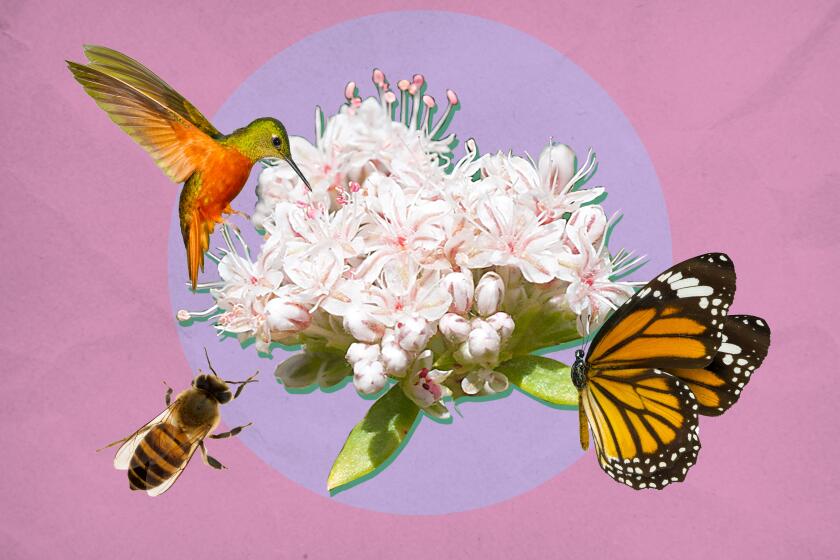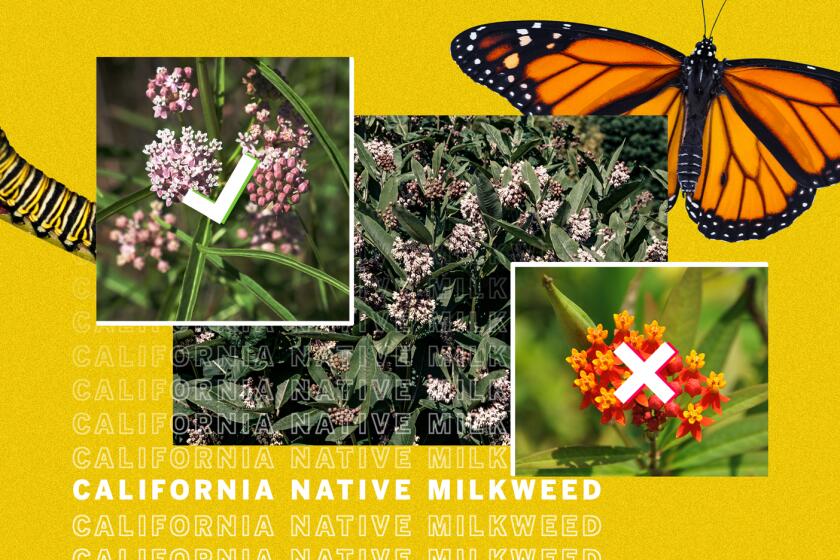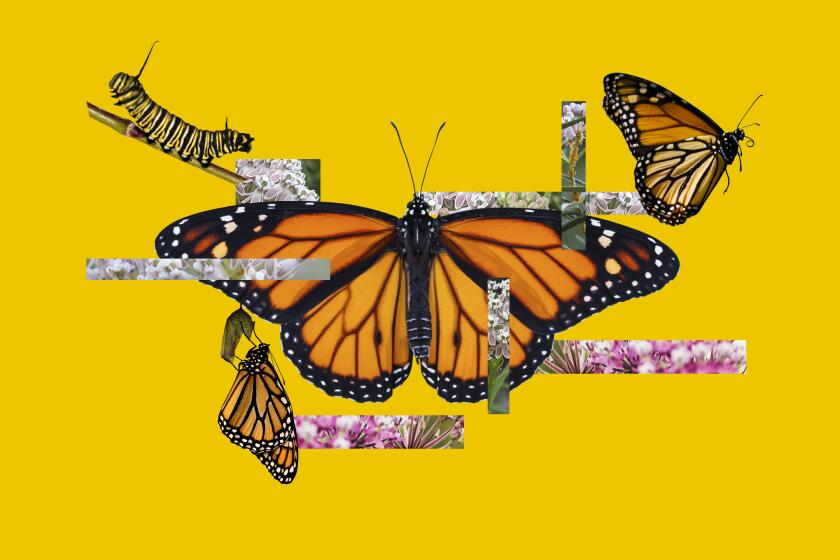Your bird feeder is canceled. Attract birds with these 13 native plants instead
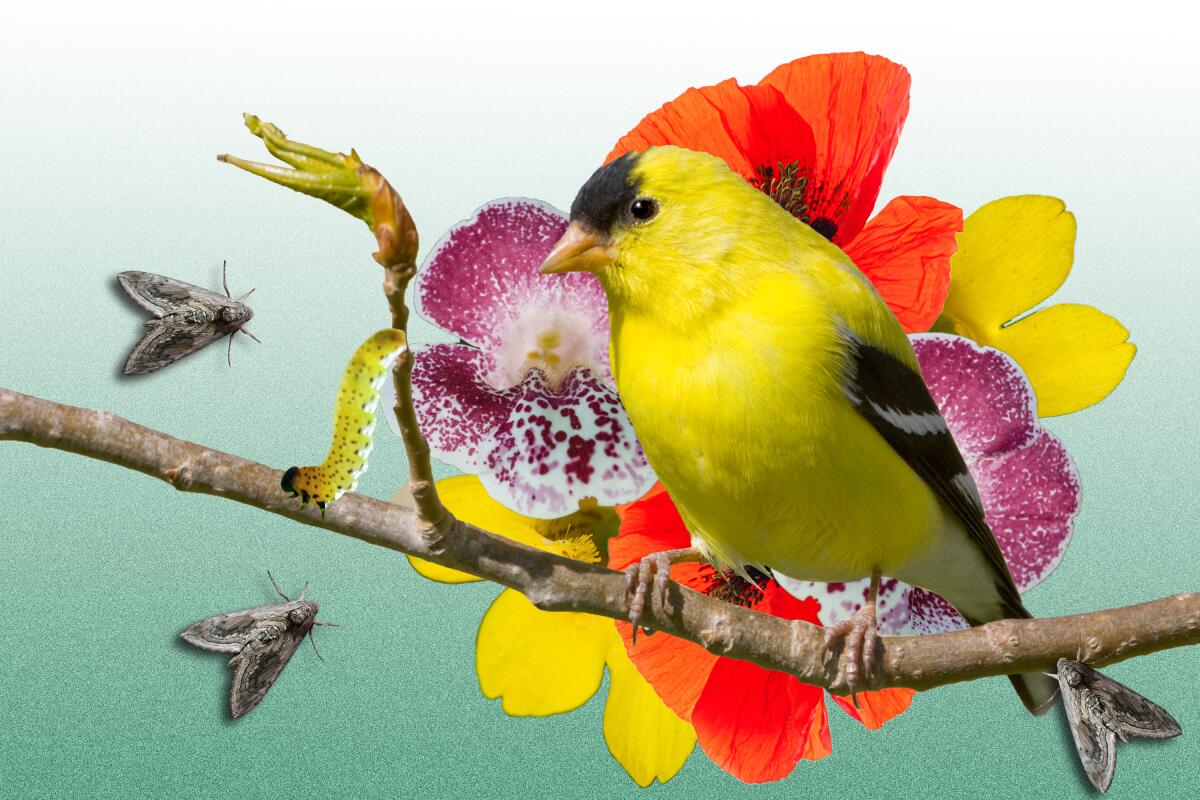
Attention wildlife fans: Bird feeders are killing songbirds, due to a vicious salmonellosis outbreak this winter. Wildlife officials in multiple Western states issued warnings earlier this year that so many birds are dying, the safest plan is to take down all our feeders, at least for now, so birds will stop congregating and spreading the disease.
So it’s time for a new strategy to attract and support our feathered friends: creating habitat in our garden space — whether it’s a balcony or backyard — by growing native plants and cultivating the food, nesting materials and shelter wild birds need to survive.
For the record:
2:33 p.m. April 20, 2021An earlier version of this story didn’t give credit for the raw data used in the Audubon Society’s Native Plants Database. The Audubon’s database draws its plant data from the North American Plant Atlas of the Biota of North American Program, directed by John Kartesz.
Think of it as treating the whole bird, says John Rowden, the National Audubon Society’s senior director of bird-friendly communities.
Why hike in Los Angeles? Lots of reasons. Use our guide to navigate 50 trails in Southern California, plus tips on gear and treats for the trail.
“We’re trying to do a better job of providing full life-cycle support for the communities we share with birds,” he said. “That’s why we’re proponents of native plantings; if done properly, you can provide food consistently over the year along with places to roost and nest.”
The Audubon Society has made it really easy to discover the most bird-friendly plants for your neighborhood with its Native Plant Database created by Rowden, using data compiled by John Kartesz, director of the Biota of North America Program. All you do is enter your ZIP Code (and, of course, your email address) to get a list of the best native plants for your area, along with nearby nurseries where they can be purchased and a list of the birds the plants are likely to attract.
The California Native Plant Society’s CalScape database and Garden Planner are additional resources for finding native plants best suited to your region.
And please note, this is much more than a landscaping tip. We’re talking about the future of our bird communities here, because the threat to their survival is high.
Birds have evolved to eat the seeds and insects native to the areas where they live, but farms, herbicides and urban development have destroyed many of those native plants, along with the insects that feed off them, causing ripples up the food chain. Think about how few insects you find on your windshield and grill these days. Then ask your parents what it was like a few decades ago, when a drive through the country left cars bristling with dead bugs. Our cars may be cleaner, but it means our birds have dwindling access to food.
We’ve gotten so feeder-focused that it’s easy to forget that insects — especially caterpillars — are a critical food for bird survival. “The vast majority of birds feed insects to their babies, independent of what they eat as adults,” Rowden said. “And caterpillars provide incredibly good packages of fat and proteins to help those babies thrive.”
Bird feeders can help supplement food for adults, but wildlife officials in California, Oregon, Washington, Utah and Idaho have gotten so many reports of sick and dead finches this year, especially the songbirds known as pine siskins, that they issued alerts warning people to take down their feeders, at least temporarily, to stop the spread of salmonellosis, Smithsonian Magazine reported last month.
The new wave in landscaping is building habitat by growing native plants, but you don’t need a yard to promote biodiversity. Hummingbirds, butterflies, bees and other pollinators are happy to dine on native plants growing on balconies or patios.
Sure, it’s fun to see birds swarming on the feeders outside our windows, but birds tend to poop where they eat, and when they congregate it spreads the salmonella bacteria. “Most birds die within 24 hours of infection,” the California Department of Fish and Wildlife agency reported on Feb. 8.
The Oregon Department of Fish and Wildlife listed tips for cleaning feeders and bird baths monthly with soap, water and diluted bleach, but overall, wildlife experts say the best course of action is to find natural ways to attract birds.
And we’re not just talking trees here. Yes, SoCal birds love a good oak or Western sycamore, but they also get lots of nourishment and support from native shrubs, perennials and annuals, because they attract insects, provide nectar and produce seeds, said Rowden.
Many native plants are magnets for pollinators such as butterflies and moths (the critters that bring us caterpillars). And lest you raise your hands in horror, we’re not talking about sacrificing baby monarch butterflies to the birds, Rowden said. Monarch caterpillars dine only on milkweed plants, whose milky sap is toxic to many animals if consumed in large quantities. The plant also tastes bad — which is why most animals avoid it — but monarch caterpillars have evolved to store those toxins in their bodies as a way to discourage predators, and it works: Their flashy black, gold and cream stripes are a tip-off to birds that these critters taste nasty.
There are other considerations too, says Marcos Trinidad, director of the Audubon Center at Debs Park in Montecito Heights. Right now, migratory birds are flying above us, looking for places to safely rest and feed, so they appreciate the cover they get from native shrubs. And residential birds are busy looking for suitable materials and places to build their nests.
Native milkweed plants — the kind good for butterflies — are coming out of dormancy and starting to sprout, so be patient. Southern California gardeners should be able to buy narrow-leaf milkweed and perhaps a few other less-well-known native milkweeds starting in mid-April.
“We find right after Easter that a lot of birds pick up the plastic Easter [basket] grass to use in their nests,” Trinidad said. The plastic stuff is a problem because chicks can get twisted and trapped in the strands and it’s too strong for them to peck through, the San Fernando Valley Audubon Society reported last year.
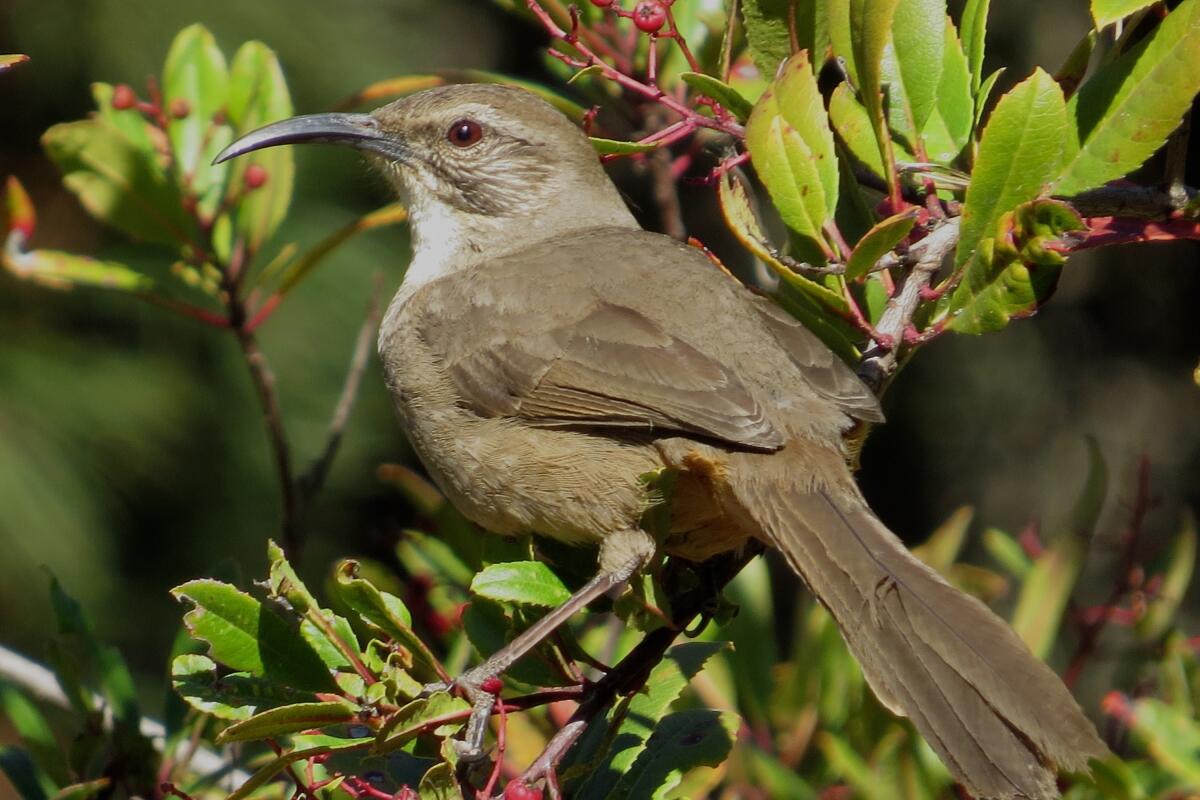
Native grasses and shrubs provide much healthier nesting materials and have the advantage of producing flowers that attract insects and develop into seed heads the birds can eat, Trinidad said.
Building habitat is about creating an ecological system, he said, which means we have to change the way we think about landscaping.
For instance, people with traditional lawns and ornamental shrubs are used to raking up the leaf debris to make everything look tidy, but that limits the benefit of native plants, Rowden said.
“One thing I tell people is don’t be compelled to do a ton of yardwork” with native plants, he said. “Many of our moth species, their caterpillars drop off into the leaf litter to complete their lives there, so if you leave leaf litter in your yard, it allows the caterpillars to complete their life cycle and the birds to dig around and find the moths and caterpillars they need to eat.”
Gardeners also remove the dead flowers from roses and other ornamental plants — a process called deadheading — to encourage new blooms, but when you do that with native plants, he said, you disrupt the symbiotic relationship between a region’s native plants and the animals that have evolved around them.
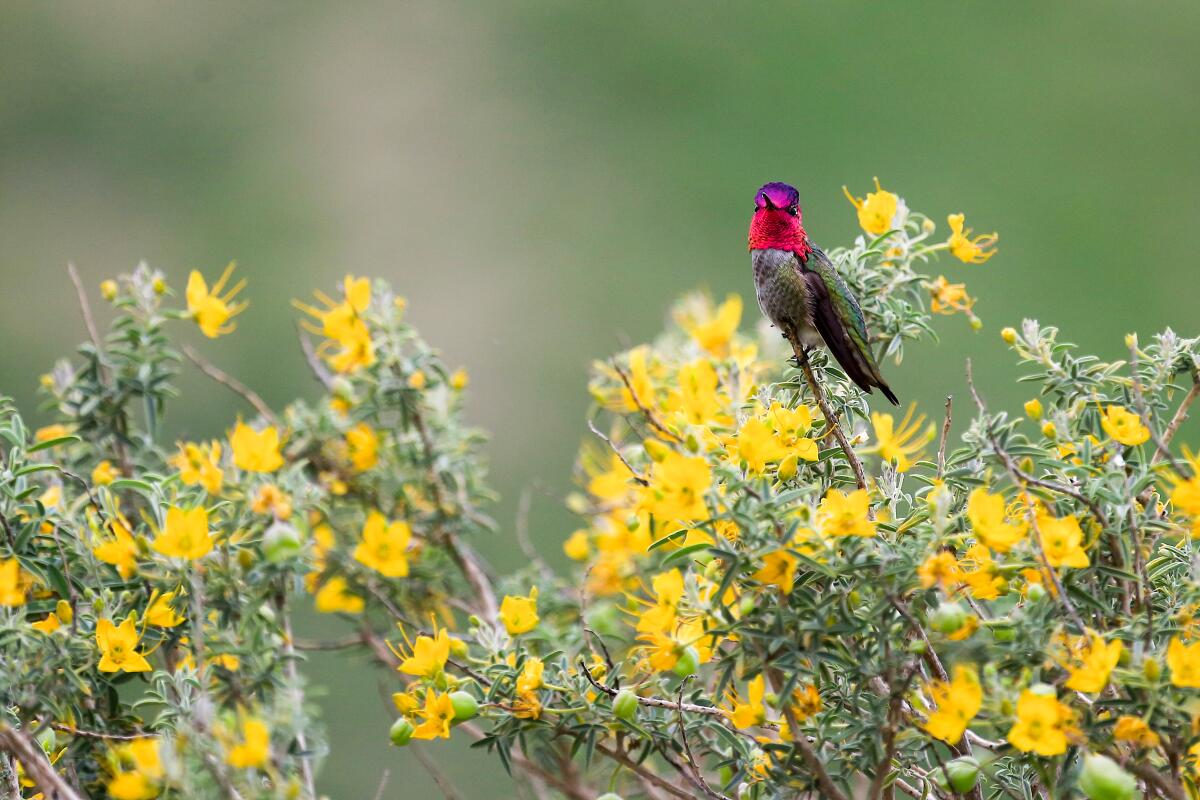
“When that really beautiful flower dries up on a native plant, it goes to seed, which allows the plant to propagate for future years or provide food for specific birds,” Trinidad said.
Monarch butterfly populations are endangered, to the point that the 1.2 million Western monarchs counted in 1997 plummeted to fewer than 2,000 by 2020. Here are ways we can help them survive.
“When you deadhead native flowers, you’re breaking the cycle, because now only pollinators are able to be involved in pollinating the plant, and the seeds, so important for food, are long gone. We have a saying with native plants: ‘You have to love the crust of bread as well.’ You have to let them go full cycle to promote all the benefits of native plants.”
That can be a tough transition if you’re used to traditional landscaping, so don’t be afraid to mix things up in your yard, Trinidad said. “When people say, ‘It’s all or nothing; you have to go full native and get rid of everything else,’ then you get into a really dark place of excluding people who might have a cultural or spiritual connection with certain plants,” he said. “Look at the food we eat; how much of that is grown as a California native? We have to try to find a balance.”
And don’t worry if you don’t have a yard. Rowden and Trinidad say they encourage people to grow native plants in containers on their patio or balcony. Even a pot of California poppies and arroyo lupine can provide insect food and seed for birds, Trinidad said. California fuchsia (Epilobium canum) and sticky monkey flowers (Mimulus aurantiacus) attract pollinators and hummingbirds and look beautiful in containers.
When growing native plants in pots, use a soil designed for containers that drains well, such as succulent soil, and choose plants according to your available sun. Many native plants prefer full sun but some, such as the fragrant, magenta-flowered hummingbird sage, prefer at least partial shade. The Audubon Society offers a guide to growing native plants in containers on its website, and the Theodore Payne Foundation is offering an online class on container growing on April 21.
Why hike in Los Angeles? Lots of reasons. Use our guide to navigate 50 trails in Southern California, plus tips on gear and treats for the trail.
13 native plants that will attract birds to your backyard
Rowden and Trinidad said it doesn’t make sense to create a specific must-have list, since the best plants for local birds will depend on your area. But in general, here’s a sampling of the plants they grow in their yards. (Trinidad lives in northeast L.A., Rowden in Venice.)
If you have the space, live oak trees are habitat stars, providing food, shelter and nesting materials for a wide variety of insects and wildlife.
Buckwheats are pollinator magnets, attracting all kinds of native bees, moths and butterflies as well as birds. The CalScape database lists more than 50 varieties.
There are more than 100 varieties of shrubs like ceanothus, also known as California lilac with its luscious clusters of blue, purple or white blooms, and red-limbed manzanita, which can grow as a groundcover, tall bush or small tree with sweet clusters of dewdrop-type flowers. Other shrubs such as currants, toyon, coffeeberry and lemonade berry have lots of flowers in the spring and colorful berries in the late summer and fall. Note that native shrubs can get very tall and wide, “but there’s no reason you can’t prune a native plant if you have limited space,” Trinidad said.
California fuchsia, with its brilliant red blooms, is a hummingbird magnet and grows well in pots, Rowden said. Other colorful options include sticky monkey flower, a shrub with sticky leaves and deep yellow blooms, and the many varieties of penstemons with their colorful, deep-throated flowers.
Sages and salvias are also good choices. There are dozens of sage varieties, some suited for shade, others for full sun, and they provide not only beautiful blooms and seed heads but an intoxicating fragrance. Just a gentle touch of hummingbird sage or Cleveland sage, for instance, could perfume an entire balcony.
Grasses, such as purple needle grass or blue-eyed grass, can add texture and movement to your garden while providing seeds, shelter for insects and a good place for birds to forage.
Looking for an even deeper dive into bird-friendly native plants?
You’re in luck! For lots more visuals and details about building habitat with native plants, check out the Theodore Payne Foundation’s 18th Native Plant Garden Tour April 16-18, a three-day online event that includes filmed tours of eight native-plant landscapes around L.A. plus panelists such as Trinidad and keynote speaker Douglas Tallamy, entomologist and author of four books about creating habitat to help wildlife, including “Bringing Nature Home: How You Can Sustain Wildlife With Native Plants.”

